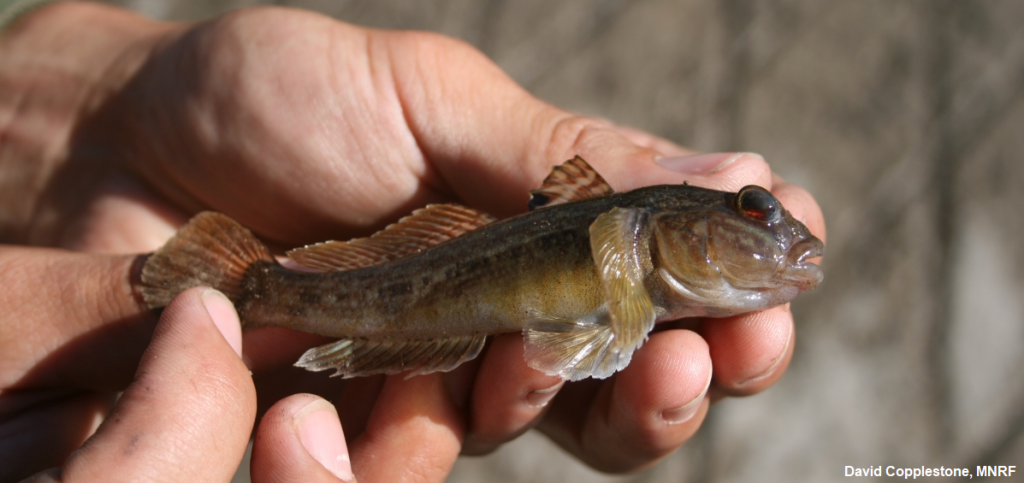Most of us have heard of the Round Goby (Neogobius melanostomus). Some of us might also know it’s an invasive species. Beyond that, however, your knowledge of the Round Goby may be a little like your knowledge of quarks: they’re something you’ve heard of, you know they’re important, but you couldn’t write more than a sentence or two about them. (Want to know about quarks? Here’s a quick explanation). Though your understanding of quarks is unlikely to affect your day-to-day life, your understanding of the Round Goby is more likely to be relevant. If you live near the Great Lakes – and especially if you go fishing in the Great Lakes – you’ll want to know a little more about the Round Goby. After all, the better we understand a species and its interactions in an ecosystem, the better we become at promoting health in that ecosystem.
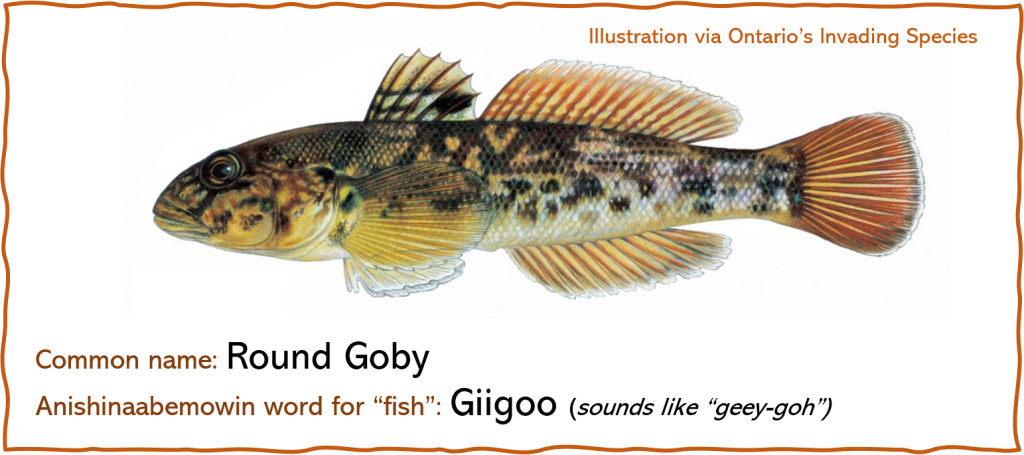
Where the Goby Goes
Let’s start with the basics. The Round Goby is a small fish that lives on the bottom of lakes, rivers, and other aquatic habitats, usually with a depth of 60 m or shallower. Round Gobies prefer rock, sand, and gravel substrate. The Round Goby is native to the Black Sea and Caspian Sea in Europe. However, in 1990 the Round Goby was found in the St. Clair River, just north of Windsor, Ontario. More Round Gobies were discovered, and within ten years Round Gobies were being spotted in all the Great Lakes. Their rapid dispersal through the Great Lakes combined with their ability to outcompete many other species makes them highly invasive.
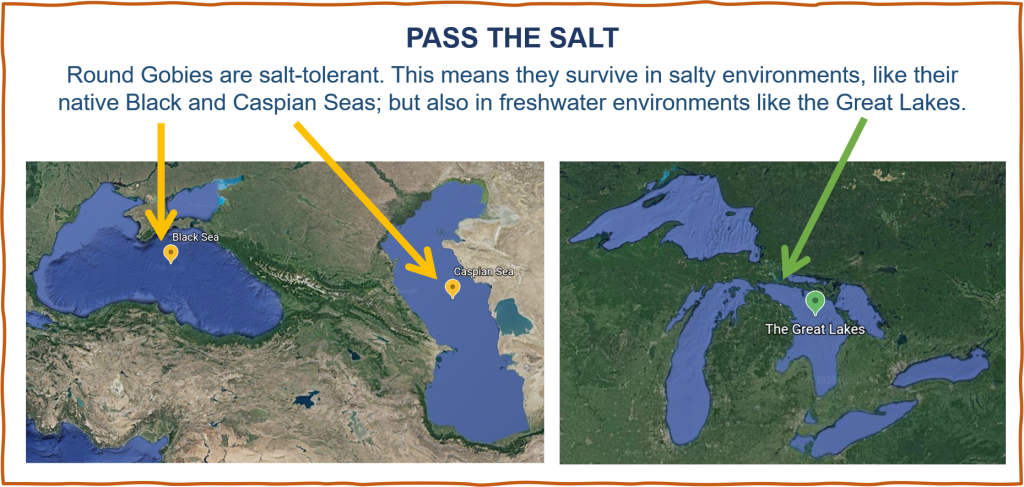
Fish and Ships, Anyone?
How did this little fish spread so quickly? Though we are not certain, most researchers think some unsuspecting Round Gobies were drawn into freighter ships as the ships filled with ballast water. Round Gobies travelled in the ships from Europe to the St. Clair River in North America (really puts the “go” in “go-by”). In North America the ships expelled their ballast water, releasing Round Gobies into the Great Lakes waterway. (What’s “ballast water”? Find out here).
Round Gobies: They’re Out to Lunch
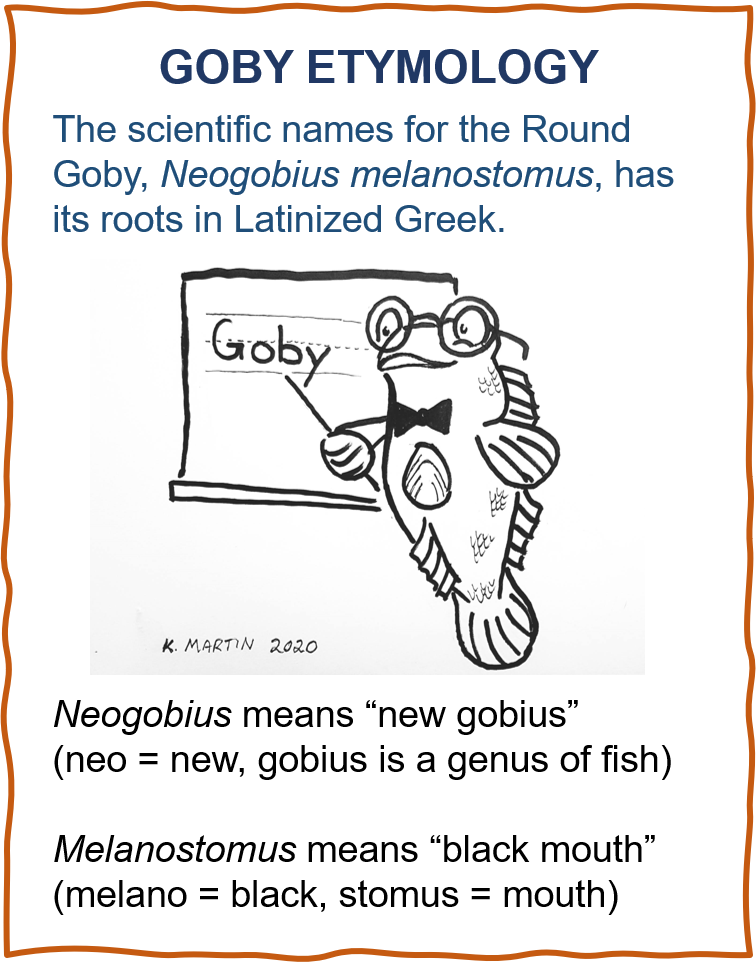
Round Gobies are invasive and outcompete the native species normally found in the Great Lakes. They are more aggressive and abundant than many of the native species, so they tend to get food before other species can. Sometimes the Round Goby will even eat the eggs of other fish or little fry. Species that are most affected by the Round Goby are those that share its benthic (bottom of water) habitat, such as Smallmouth Bass and Lake Trout.
Round Gobies are voracious eaters. They eat aquatic insects, mussels, and sometimes smaller fish such as darters. Interestingly, two major food sources for the Round Goby are the invasive Zebra Mussel and Quagga Mussel. Our native fish species have not had much time to adapt to eating these mussels, so fish generally avoid them. This leaves large quantities of these invasive mussels available as a food source to fuel rapidly-growing populations of the Round Goby.
Curious as to why the Round Goby eats Zebra Mussels and Quagga Mussels? These mussel species are endemic (native) to the Black Sea and Caspian Sea – just like the Round Goby. It is probable that the Round Goby is used to eating these mussels because it has historically eaten them in its original range in Europe.

The Round Goby also has an advantage over many of our native fish species because they have a well-developed sensory system that allows a goby to detect small movements of the water around it. For example, even in dark environments a Round Goby can detect prey based on how the movement of the prey causes small shifts in the surrounding water.

Eat… And Be Eaten?
There is an interesting dynamic between the Round Goby and some of the native fishes in the Great Lakes. Gobies are both predator and prey for some of these species. Though the Round Goby will eat the eggs of some sportfish, those same species will eat the Round Goby. For example, the Round Goby is an easy and abundant food for Smallmouth Bass, Largemouth Bass, Walleye, and Yellow Perch. Even Lake Sturgeon are known to eat Round Gobies. The Round Goby is also a food source for fish-eating birds such as gulls, cormorants, and loons.

However, there is a risk for species that eat Round Gobies. Zebra Mussels, which Round Gobies eat, can carry a toxin that causes Botulism Type E. The toxins are not an issue for the mussels, but Botulism can be a fatal disease for fish and birds. A Round Goby that eats a toxin-carrying mussel can become infected with Botulism. If that goby is eaten by another fish or a bird (before the disease kills the goby), the disease gets passed on to the predator. Mass die-offs of fish and birds have been reported due to outbreaks of Botulism.
“Goby-ond” and Help Limit the Spread
Wondering if there’s anything you can do to limit the negative effects of the Round Goby on the Great Lakes ecosystem? Here are the main ways to help reduce the spread of the Round Goby through our waterways:
- Do not buy or use Round Goby as a baitfish. Do not buy or use Round Goby for any other reason.
- Report sightings of Round Goby using the Invading Species Hotline (1-800-563-7711) or online via the Ontario Invading Species Program.
- If you catch a Round Goby (and you’re certain of your identification), kill the fish and dispose of it in the garbage. If you are unsure of your identification, keep the fish separate (e.g. in a bucket of water) and alive while you contact the Invading Species Hotline (1-800-563-7711) for guidance.
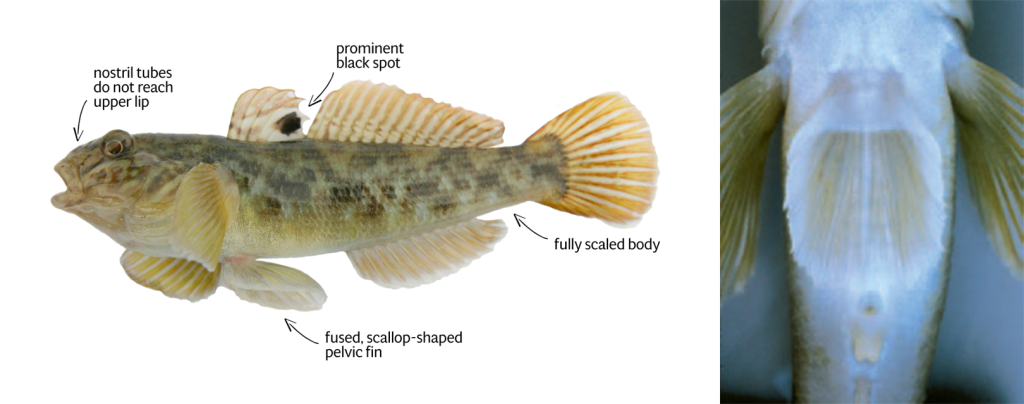
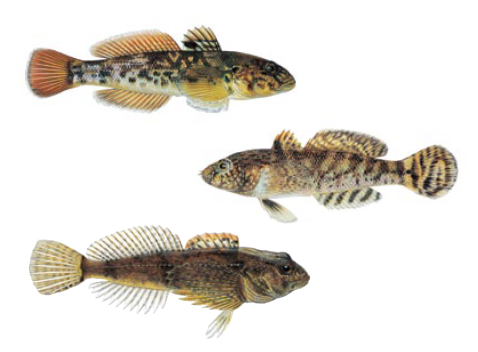
The Round Goby looks similar to several species of fish found in the Great Lakes, including the invasive Tubenose Goby (Myoxocephalus thompsoni) and native Sculpins (Cottus sp.). Top: Round Goby. Middle: Tubenose gobies (invasive) lack a black spot on the dorsal fin and have small nostril tubes that extend over the upper lip. Bottom: Sculpins (native) lack a black spot on the first dorsal fin and have two separate pelvic fins. Images from Invasive Species Centre.
Further Reading
Map for exploring goby observations
Ontario’s Invading Species Awareness Program – Round Goby
U.S. Geological Survey – Round Goby
Ray, W. J., & Corkum, L. D. (n.d.). Predation of zebra mussels by round gobies, Neogobius melanostomus. 7. PDF available online.

Kayla Martin joined the Georgian Bay Biosphere this year as an Interpretive Guide. She is a recent grad of the University of Guelph’s Ecology program and is excited to share her enthusiasm for wildlife and landscapes in the Biosphere. She hopes to accomplish this by combining her artistic hobbies with her knowledge of ecology.
